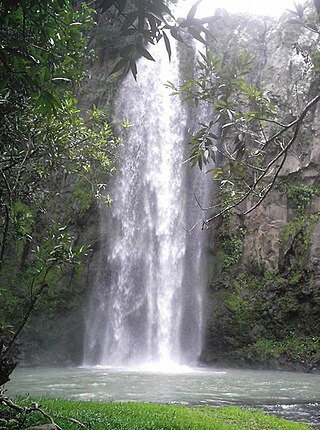Central America (Spanish: América Central, pronounced [aˈmeɾika senˈtɾal] (![]() listen) or Centroamérica pronounced [sentɾoaˈmeɾika] (
listen) or Centroamérica pronounced [sentɾoaˈmeɾika] (![]() listen)) is the central geographic region of the continent known as the Americas. It goes from Mexico in the north-west, to Panama in the south-east.
listen)) is the central geographic region of the continent known as the Americas. It goes from Mexico in the north-west, to Panama in the south-east.

| Central America | |
|---|---|
 | |
| Area | 523,780 km2 (202,233 sq mi)[1] |
| Population | 43,308,660 (2013 est.) |
| Density | 77/km2 (200/sq mi) |
| Countries | 7 |
| Demonym | Central American, North American |
| GDP | $107.7 billion (exchange rate) (2006) $ 226.3 billion (purchasing power parity) (2006). |
| GDP per capita | $2,541 (exchange rate) (2006) $5,339 (purchasing power parity) (2006). |
| Languages | Spanish, English, Mayan languages, Garifuna, Kriol, European languages, and many others |
| Time Zones | UTC - 6:00, UTC - 5:00 |
| Most Populated Cities | |
Central America has an area of 524,000 square kilometers (202,000 sq mi). It is almost 0.1% of the Earth's surface. This is a list of the countries in Central America, from the largest to the smallest:
 Nicaragua (130,372 km2)
Nicaragua (130,372 km2) Honduras (112,090 km2)
Honduras (112,090 km2) Guatemala (108,890 km2)
Guatemala (108,890 km2) Panama (78,200 km2)
Panama (78,200 km2) Costa Rica (51,100 km2)
Costa Rica (51,100 km2) Belize (22,966 km2)
Belize (22,966 km2) El Salvador (21,040 km2)
El Salvador (21,040 km2)
While Nicaragua is the largest country in area, of Central America, Guatemala has the largest population by country in Central America, with more than 14 million people and they also have the most populated city in Central America, being Guatemala City.

Six of the seven countries have Spanish as their official language, with Belize being the non-Spanish speaking country, as their official language is English, although there are now at least 195,597 (62.8%) of people in Belize who speak Spanish.[2]
Some people also speak indigenous or creole languages like the Maya languages.
Central America has a density of 77 people per square kilometer.
Geography

Central America has an area of 524,000 square kilometers (202,000 sq mi). It is almost 0.1% of the Earth's total surface. In 2009 the population was estimated at 41,739,000. It has a density of 77 people per square kilometer or 206 people per square mile.
Physical geography

Central America has many unique features that go from the north-western borders of Belize and Guatemala to the Isthmus of Panama. There it connects to the Colombian Pacific Lowlands in South America.
Central America is an area of some 524,000 square kilometres. The Pacific Ocean is on the southwest, the Caribbean Sea to the northeast, and the Gulf of Mexico to the north. Most of Central America rests on the Caribbean Plate.
The region is geologically active. It has volcanic eruptions and earthquakes from time to time.
The 1976 Guatemala earthquake killed 23,001 people. Managua, the capital of Nicaragua, was devastated by earthquakes in 1931 and 1972. The last one killed about 5,001 people. Three earthquakes hit El Salvador. The first one in 1986 and two in 2001. An earthquake devastated northern and central Costa Rica in 2009. It killed at least 35 people. In Honduras a powerful earthquake happened in 2009.
Volcanic eruptions are common. In 1968 the Arenal Volcano in Costa Rica erupted. This killed at least 87 people. The 3 villages of Tabacon, Pueblo Nuevo, and San Luis were buried under ash.
Central America has many mountain ranges; the longest are the Sierra Madre de Chiapas, the Cordillera Isabelia and the Cordillera de Talamanca. Most of the population of Honduras, Costa Rica and Guatemala live in valleys, between mountains. Valleys are also suitable for the production of coffee, beans and other crops.
Biodiversity



Central America is part of the Mesoamerican Biodiversity hotspot, boasting 7% of the world's biodiversity.[3] As a bridge between North and South America, Central America has many species from the Nearctic and the Neotropic ecozones. However the southern countries (Costa Rica and Panama) of the region have more biodiversity than the northern countries (Guatemala and Belize), meanwhile the central countries (Honduras, Nicaragua and El Salvador) have least biodiversity.[3] The table shows current statistics for the seven countries:
| Country | Amphibians | Birds | Mammals | Reptile | |||
|---|---|---|---|---|---|---|---|
| 46[4] | 544[4] | 147[4] | 140[4] | 877[4] | 2894[4] | 3771[4] | |
| 183[5] | 838[5] | 232[5] | 258[5] | 1511[5] | 12119[5] | 13630[5] | |
| 30[6] | 434[6] | 137[6] | 106[6] | 707[6] | 2911[6] | 3618[6] | |
| 133[7] | 684[7] | 193[7] | 236[7] | 1246[7] | 8681[7] | 9927[7] | |
| 101[8] | 699[8] | 201[8] | 213[8] | 1214[8] | 5680[8] | 6894[8] | |
| 61[9] | 632[9] | 181[9] | 178[9] | 1052[9] | 7590[9] | 8642[9] | |
| 182[10] | 904[10] | 241[10] | 242[10] | 1569[10] | 9915[10] | 11484[10] |
References
Wikiwand in your browser!
Seamless Wikipedia browsing. On steroids.
Every time you click a link to Wikipedia, Wiktionary or Wikiquote in your browser's search results, it will show the modern Wikiwand interface.
Wikiwand extension is a five stars, simple, with minimum permission required to keep your browsing private, safe and transparent.
